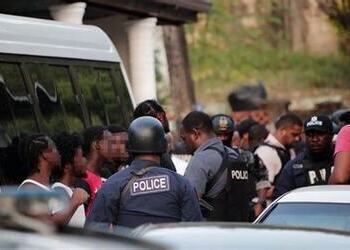Gang violence in Trinidad and Tobago is on the rise, and without significant policy changes, predictive models suggest the trend will worsen over the coming years.
The country has experienced a sharp spike in homicides in 2024, with 413 cases as of August 26, surpassing the figures from the same period over the previous five years. With a homicide rate of 26 per 100,000 people, Trinidad and Tobago not only exceeds last year’s rates in Colombia and Mexico, but is on pace to surpass the record 605 murders reported in 2022, with projections that homicides could hit a new high of 635 by the end of the year.
SEE ALSO: Do Gang Truces Prevent Violence in Trinidad and Tobago?
Criminologist Randy Seepersad’s predictive model forecasts an even more troubling future, projecting homicides could hit 700 by 2030 if Trinidad and Tobago continues down its current path. This model acts as “a warning system,” said Seepersad in an interview with InSight Crime. “And it should be used as a means to signal that things are reaching a level that something serious needs to be done.”
According to official data, gang-related violence in 2024 accounts for 42.6% of the murders, with 10.7% linked to drug activity, and 8.4% attributed to revenge killings – all categories linked to organized crime in the country, according to officials from the Trinidad and Tobago Police Service (TTPS).
While the government has rolled out several community-based anti-gang initiatives since 2015 to tackle violence, the programs were not continued, limiting their effectiveness. Rivalries, particularly between the Sixx and Rasta City gangs, and easy access to weapons have fueled bloodshed in the twin-island Caribbean nation, as they vie for the spoils from illegal gambling, human smuggling, and robberies, among other criminal activities.
InSight Crime Analysis
Predictive modeling anticipates worsening gang-related violence in Trinidad and Tobago unless key changes are made.
These methods of analysis typically rely on historical data to find patterns and then use that to predict what may happen in the near future.
Seepresad’s predictions, based on historical crime data going back to 1990, uses the autoregressive integrated moving average, or ARIMA, method to predict future homicide trends, then uses the averages to gauge the future.
This method works by analyzing patterns over a specific time, say three years. It calculates the trend for those years, then predicts the fourth year will follow the same tendency. The difference between the predicted and actual values for the fourth year becomes part of the model’s error, and the process is extended to the next three years, and so on. Once the model runs out of data, it stretches the latest trend out for the future years, with the error averaged over the entire model to indicate the level of confidence in the projection. Essentially, the model takes a snapshot of the current situation and then predicts future numbers if changes are not made.
The ARIMA approach to building predictions is considered one of the most accurate when working with data across time and is often used in peer-reviewed research, explained Seepersad. “There are limitations to any type of predictive models that you do, but [ARIMA] is one of the [methods] that’s recognized as a very robust approach.”
SEE ALSO: Why Are Trinidad and Tobago’s Gangs Becoming More Violent?
ARIMA models base their predictions on the environment remaining unchanged. This doesn’t mean Trinidad and Tobago is doomed to hit 700 homicides in 2030, rather that it probably will if current conditions persist.
“The massive limitation of any predictive model is that it assumes that all else is equal. So it looks at past crime trends, and it assumes no significant change in the future in terms of any variable that could affect the crime trends,” said Seepersad.
That means that Trinidad and Tobago could still buck the trend, but this would likely require changes to its complex criminal and social panorama. “There is a lot behind the issue of gangs … like social isolation of communities, lack of access to jobs and other legitimate opportunities,” Seepersad explained.
The violence is exacerbated by gang rivalries and easy access to weapons. Homicides steadily increased every year from 2014 to 2019, a trend that was aggravated when the Sixx gang broke off from the Rasta City gang in 2017, becoming bitter rivals. While lockdowns during the COVID-19 pandemic briefly interrupted the trend in 2020, homicide levels were back to pre-pandemic levels by 2021. Violence exploded in 2022, resulting in a record 605 homicides, and despite a slight drop in 2023, it was the still second-deadliest year on record. Now, 2024 threatens to be even worse as fighting between Rasta City and Sixx intensifies.
Featured image: Trinidad and Tobago police detain suspected gang members. Credit: Abraham Diaz
Source link : http://www.bing.com/news/apiclick.aspx?ref=FexRss&aid=&tid=66e83b2137044f379661136c17e49df7&url=https%3A%2F%2Finsightcrime.org%2Fnews%2Fprediction-rising-homicides-trinidad-tobagogang-violence%2F&c=13482700612934664453&mkt=en-us
Author :
Publish date : 2024-09-12 07:19:00
Copyright for syndicated content belongs to the linked Source.





